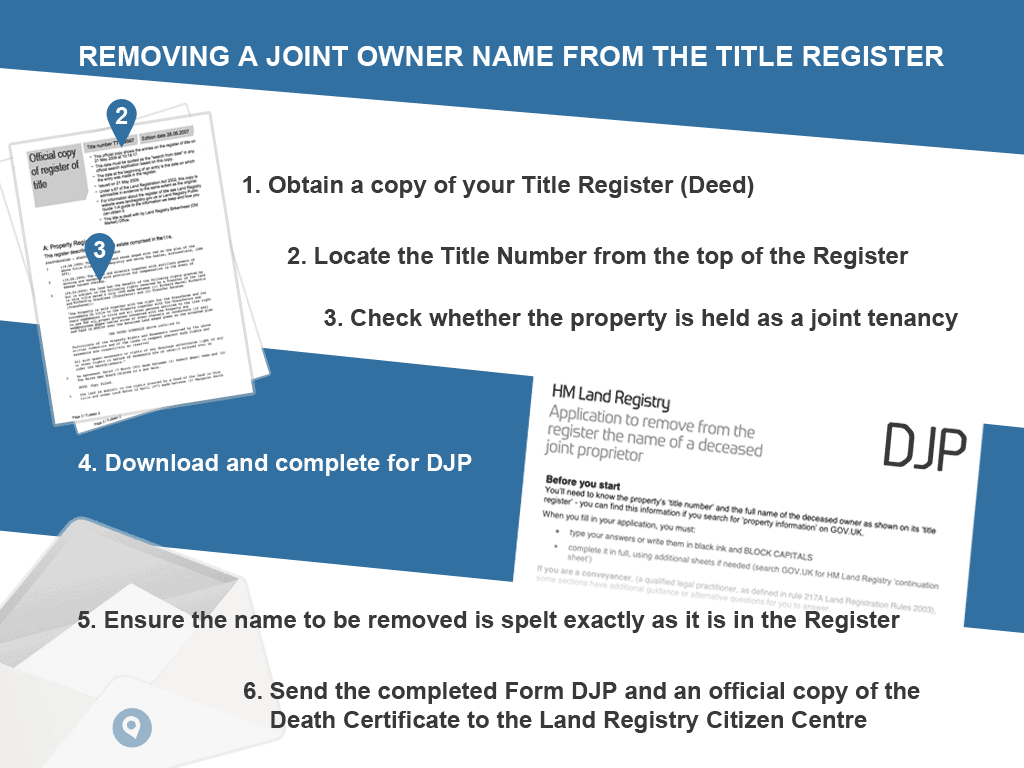Removing a name from Land Registry Title Deeds
Contents
Removing a Joint Owner's Name from the Property Deeds when they have Died
This is perhaps one of the most common reasons why a name would need to be removed from a Title Deed. We've broken down the process into easy to follow steps below:

- Have your Title Register to hand.
- Obtain the Title Number from the top of the Register.
- Check whether the property is held as a joint tenancy.
- Obtain Form DJP from the Government website and complete it.
- Ensure the name to be removed is spelt exactly as it is in the Register.
- Send the completed Form DJP and an official copy of the Death Certificate to the Land Registry Citizen Centre.
Home Ownership After the Death of a Husband or Wife
A common query a surviving spouse has, following the death of his or her loved one, is how to change the Land Registry Title Register to show the change in ownership. This, of course, means to remove the name of the deceased spouse, leaving the surviving spouse shown as the sole owner.
Joint Tenancy Ownership
When a house is owned by two or more people, e.g. a husband and wife, as joint tenants in equity, which is usually the way a property is held, each owner has a 100% share of the property. This means that when one of the owners die the other owner assumes ownership of the property as right of survivor. There is no need to transfer the property as the survivor already owns a 100% share in it. This is so, even where there are more than two owners.
Uncertainty of Ownership Type
If you are not sure whether you own the property as a Joint Tenant or as a Tenant in Common you should look at a recent copy of the Title Register, B section, for the following clause:
RESTRICTION: No disposition by a sole proprietor of the registered estate (except a trust corporation) under which capital money arises is to be registered unless authorised by an order of the Registrar or the court.
If this wording is present it means there is a tenancy in common and you will need to instruct a solicitor to convey the property into your sole name and then apply for registration at the Land Registry. If the wording is not present it means the property is registered as a beneficial joint tenancy. Select the link to learn more about beneficial joint tenancies and tenancies in common.
Removing the Deceased's Name at the Land Registry
The Land Registry should be informed of the death and the Title Register changed to the sole name of the surviving owner. If this is not done there may be difficulties when attempting to obtain official documents such as a passport, driving licence, etc. This is because official organisations will usually check your identity by looking at the Land Registry records.
Making the change at the Land Registry requires the completion of Form DJP. This is available for free from the Government website. You will need to send this, together with evidence of the death (death certificate, grant of probate or letters of administration), to the Land Registry. You can send these documents to:
HM Land Registry Citizen Centre
PO Box 74
Gloucester
GL49 9BB
The Title Register
You need this to:
- Check the exact names and spellings of the deceased (B section)
- Check that the property is owned as a Joint Tenancy (B section)
- Obtain the Title Number (top of the Register)
Obtain an up to date copy of the Title Register
Summary of Documents to be sent to Land Registry
- Completed Form DJP
- Evidence of Death - official copy of Death Certificate, or official copy of Grant of Probate, or official copy of Letters of Administration
Title Register
The Land Registry Title Register holds data relating to the property ownership, purchase price, mortgage, tenure, covenants, rights of way, leases and class of title.
£19.95Title Plan
The Title Plan shows an outline of the property and its immediate neighbourhood, and uses colours to identify rights of way, general boundaries and land affected by covenants.
£19.95Associated Documents
Deeds creating Restrictions, Covenants, Easements, etc. are often kept digitally by the Land Registry and made available for sale due to their invaluable detail and content to assist in further understanding the Restrictions, etc.
£29.95


